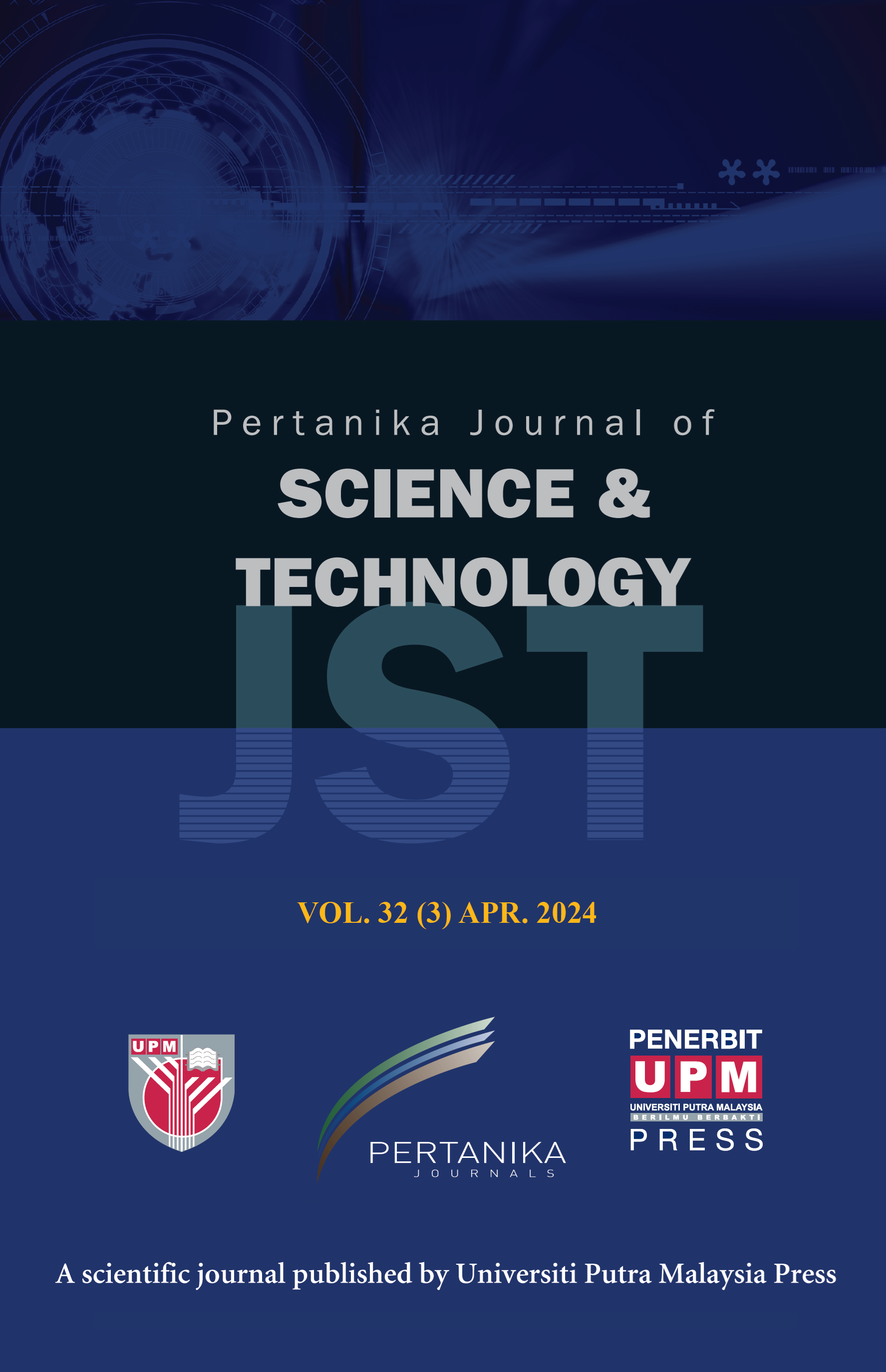PERTANIKA JOURNAL OF SCIENCE AND TECHNOLOGY
e-ISSN 2231-8526
ISSN 0128-7680
J
J
Pertanika Journal of Science & Technology, Volume J, Issue J, January J
Keywords: J
Published on: J
J
-
Ab Dollah, R., & Shah, P. M. (2016). A comparison between vocabulary learning strategies employed by urban and rural schools students. Journal of Education and Social Sciences, 4, 114-121.
-
Alsup, J. (Ed.). (2010). Young adult literature and adolescent identity across cultures and classrooms: Contexts for the literary lives of teens. Routledge. https://doi.org/10.4324/9780203853139
-
Amini, A. (2020). Social identity: A composite concept in Social Sciences research. Journal of Social Sciences and Humanities Research, 8(3).
-
Baharudin, R., Hong, C. Y., Lim, S. J., & Zulkefly, N. S. (2010). Educational goals, parenting practices and adolescents’ academic achievement. Asian Social Science, 6(12), 144-152. https://doi.org/10.5539/ass.v6n12p144
-
Ball, R., & Chik, R. (2001). Early employment outcomes of foreign and educated graduates: The Malaysian experience. Higher Education, 42(2), 171-189. https://doi.org/10.1023/A:1017579415737
-
Benson, P., Barkhuizen, G., Bodycott, P., & Brown, J. R. (2013). Second language identity in narratives of study abroad. Palgrave Macmillan. https://doi.org/10.1057/9781137029423
-
Besser, S., & Chik, A. (2014). Narratives of second language identity amongst young English learners in Hong Kong. ELT Journal, 68(3), 299-309. https://doi.org/10.1093/elt/ccu026
-
Block, D. (2007). The rise of identity in SLA research, post Firth and Wagner (1997). The Modern Language Journal, 91, 863-876. https://doi.org/10.1111/j.1540-4781.2007.00674.x
-
Campbell, J. (2018). English language and an inclusive Malaysia. 3L: The Southeast Asian Journal of English Language Studies, 24(3), 206-219. http://doi.org/10.17576/3L-2018-2403-15
-
Chang, M., & Goswami, J. S. (2011). Factors affecting the implementation of communicative language teaching in Taiwanese college English classes. English Language Teaching, 4(2), 3-12. https://doi.org/10.5539/elt.v4n2p3
-
Creswell, J. (2012). Educational research planning, conducting, and evaluating quantitative and qualitative research (4th ed.). Pearson.
-
Crismore, A., Ngeow, K. Y. H., & Soo, K. S. (1996). Attitudes toward English in Malaysia. World Englishes, 15(3), 319-335. https://doi.org/10.1111/j.1467-971X.1996.tb00118.x
-
Curry, L. (2016). Fundamentals of qualitative research methods [Video]. Yale University. https://www.youtube.com/watch?v=wbdN_sLWl88
-
De Fina, A. (2012). Discourse and identity. The Encyclopedia of Applied Linguistics, 1-8.
-
Department of Statistics Malaysia. (2020). Population and Housing Census. https://www.dosm.gov.my/v1/index.php?r=column/cone&menu_id=bDA2VkxRSU40STcxdkZ4OGJ0c1ZVdz09
-
Eisner, E. (2014). Objectivity in educational research. Curriculum Inquiry, 22(1), 9-15. https://doi.org/10.1080/03626784.1992.11075389
-
Etemadi, A. (2012). Effects of bimodal subtitling of English movies on content comprehension and vocabulary recognition. International Journal of English Linguistics, 2(1), 239. https://doi.org/10.5539/ijel.v2n1p239
-
Firth, A., & Wagner, J. (1997). On discourse, communication, and (some) fundamental concepts in SLA research. The Modern Language Journal, 81(3), 285-300. https://doi.org/10.1111/j.1540-4781.1997.tb05480.x
-
Francis, J. J., Johnston, M., Robertson, C., Glidewell, L., Entwistle, V., Eccles, M. P., & Grimshaw, J. M. (2010). What is an adequate sample size? Operationalising data saturation for theory-based interview studies. Psychology and Health, 25(10), 1229-1245. https://doi.org/10.1080/08870440903194015
-
Gaudart, H. (1987). English Language Teaching in Malaysia: A historical account. The English Teacher, 16(1987), 17-36.
-
Glaeser, E. L. (1999). Learning in cities. Journal of Urban Economics, 46(2), 254-277. https://doi.org/10.1006/juec.1998.2121
-
Gobel, P., Thang, S. M., Sidhu, G. K., Oon, S. I., & Chan, Y. F. (2013). Attributions to success and failure in English language learning: A comparative study of urban and rural undergraduates in Malaysia. Asian Social Science, 9(2), 53-62. https://doi.org/10.5539/ass.v9n2p53
-
Hanapi, Z., & Nordin, M. S. (2014). Unemployment among Malaysia graduates: Graduates’ attributes, lecturers’ competency and quality of education. Procedia-Social and Behavioral Sciences, 112(2014), 1056-1063. https://doi.org/10.1016/j.sbspro.2014.01.1269
-
Kim, L. S. (2006). Masking: Maneuvers of skilled ESL speakers in postcolonial societies. In A. Hashim & N. Hassan (Eds.), English in South East Asia: Prospects, perspectives and possibilities. University of Malaya Press.
-
Kudrna, L., Furnham, A., & Swami, V. (2010). The influence of social class salience on self-assessed intelligence. Social Behavior and Personality: An International Journal, 38(6), 859-864. https://doi.org/10.2224/sbp.2010.38.6.861
-
LeCompte, M., & Schensul, J. (1999). Analyzing & interpreting ethnographic data. Altamira.
-
Lim, H. E. (2010). Predicting low employability graduates: The case of University Utara Malaysia. The Singapore Economic Review, 55(03), 523-535. https://doi.org/10.1142/s0217590810003870
-
Norton, B. (1997). Language, identity, and the ownership of English. TESOL Quarterly, 31(3), 409-429. https://doi.org/10.2307/3587831
-
Norton, B., & McKinney, C. (2011). An identity approach to second language acquisition. In D. Atkinson (Ed.), Alternative approaches to Second Language Acquisition (pp. 73-94). Routledge.
-
Rajadurai, J. (2011). Crossing borders: The linguistic practices of aspiring bilinguals in the Malay community. Australian Review of Applied Linguistics, 34(1), 24-39. https://doi.org/10.1075/aral.34.1.02raj
-
Roshid, M. M., & Chowdhury, R. (2013). English language proficiency and employment: A case study of Bangladeshi graduates in Australian employment market. Mevlana International Journal of Education, 3(1), 68-81.
-
Sarudin, I., Zubairi, A. M., Nordin, M. S., & Omar, M. A. (2008). The English language proficiency of Malaysian public university students. In Enhancing the Quality of Higher Education Through Research: Shaping Future Policy (pp. 40-65). The Ministry of Higher Education (MOHE) Malaysia.
-
Sekharan Nair, G., Rahim, R., Setia, R., Husin, N., Sabapathy, E., Abd Jalil, N., Razlan, R. M., Mohamad, R., Mat So’od, S. M., Md Yusoff, N. I., Mohamed, N. M., & Abu Seman, N. (2012). Malaysian graduates English adequacy in the job sector. Asian Social Science, 8(4), 143-147. https://doi.org/10.5539/ass.v8n4p143
-
Selvaratnam, V. (2019). Malaysia: National language policy and employability. International Higher Education, 96(Winter), 16-18. https://doi.org/10.6017/ihe.2019.96
-
Swami, V., & Furnham, A. (2010). Self-assessed intelligence: Inter-ethnic, rural–urban, and sex differences in Malaysia. Learning and Individual Differences, 20(1), 51-55. https://doi.org/10.1016/j.lindif.2009.11.002
-
Ting, S. H., Marzuki, E., Chuah, K. M., Misieng, J., & Jerome, C. (2017). Employers’views on importance of English proficiency and communication skill for employability in Malaysia. Indonesian Journal of Applied Linguistics, 7(2), 315-327. https://doi.org/10.17509/ijal.v7i2.8132
-
Wahid, R., & Pilus, Z. (2017). Learning English in a third space? Malay students in an English-speaking university in Malaysia. Journal of Social Sciences & Humanities, 25(3), 1167-1180.
-
Zainuddin, S. Z. B., Pillai, S., Dumanig, F. P., & Phillip, A. (2019). English language and graduate employability. Education+Training, 61(1), 79-93. https://doi.org/10.1108/ET-06-2017-0089
ISSN 0128-7680
e-ISSN 2231-8526




